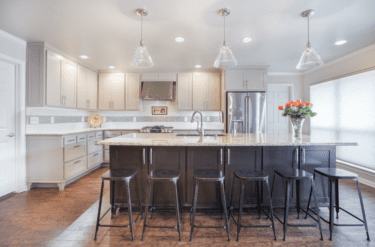Cooler temperatures outside means it’s time to heat the inside; which could result in a higher electricity bill. Here are some tips to help you keep your home warm and your bills low this fall and winter!
1. Take Advantage of Natural Heat
Opening curtains on your south-facing windows during the day is a great way to cut your energy costs by warming your home naturally. In the evenings, when the sun starts to set, be sure to close your blinds and curtains to minimize the chill from cold windows and retain the heat in your home throughout the night.
2. Cover Drafty Windows
Add an extra layer to drafty windows by using a heavy-duty plastic sheet or taping clear plastic film to the inside of your window frames. Make sure the plastic is sealed tightly to the frame to help reduce infiltration of cold air. Tight fitting, insulating drapes or shades can also be very helpful in controlling any draft from the windows.
3. Adjust Your Thermostat
When you are home, practice setting your thermostat as low as is comfortable. This can be quite an adjustment if you are cold natured, but investing in warm clothes, a stocking hat and a good pair of house shoes should help!
When you are asleep or out of the house, get into the habit of turning your thermostat down 10° to 15° for eight hours per day / night. This can add up to around 10% savings a year on your heating and cooling bills! A programmable thermostat can easily make this an automatic function.
4. Find & Seal Leaks
Utility cut-throughs for pipes often have air leaks that need to be sealed. Chimneys and recessed lights in insulated ceilings also often have small gaps that can be the source of cold air. Adding caulk or weather stripping to these spaces is an easy, affordable way to seal leaks and lock out cold air.
5. Maintain Your Heating Systems
It’s a good idea to schedule routine service for your home’s heating system. Make sure you are educated on what maintenance is required to keep your heating system operating efficiently. For furnaces, replace your furnace filter once a month or as needed. For wood and pellet-burning heaters, clean the flue vent regularly, as well as the inside of the appliance with a wire brush periodically.
6. Minimize Heat Loss from the Fireplace
One of the most important tips is to reduce heat loss during the winter is to keep your fireplace damper closed unless a fire is burning. Keeping the damper open is like keeping a window wide open; it allows warm air to escape right out the chimney. When you use the fireplace, reduce heat loss by opening dampers in the bottom of the firebox (if provided) or open the nearest window slightly — and close doors leading into the room. You can also lower the thermostat setting to between 50° and 55°F.
If you never use your fireplace, plugging and sealing the chimney flue is your best option for maintaining heat in your home. If you do use the fireplace, install tempered glass doors and a heat-air exchange system that blows warmed air back into the room.
7. Lower Water Heating Costs
Did you know that water heating can account for 14% to 25% of the energy consumed in your home? You can save some energy (and some money) by turning down the temperature of your water heater to the warm setting (120°F). You’ll not only save energy, you’ll avoid scalding your hands when you turn on the hot water. Read more about water heater temperatures here: http://askmikeabouthomeremodeling.com/category/water-heater/
8. Lower Holiday Lights Cost
It just doesn’t feel like the holidays without holiday lights, but consistent use can definitely increase your energy bill. Try using light-emitting diode — or “LED” — holiday light strings to reduce the cost of decorating your home for the winter holidays.
If you need help winterizing your home, contact us!
Stay Warm!
Mike








